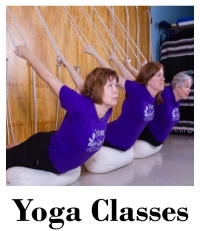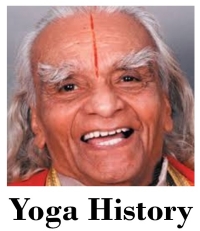FAQ
Our FAQ page is designed to provide you answers to frequently asked questions, some do's and don'ts and good information. Yoga has become very popular all over the world. We want you to enjoy all the benefits Yoga has to offer to the mind, spirit and body.
Frequently
Asked Questions about attending yoga class.
What happens if I arrive late to class?
Although we all try to arrive at the studio a few minutes early in order to be set up in the classroom and ready to begin at class time, sometimes we are a little late and class has already begun.
The invocation part of the class is mediation and a chance for all to become quiet and settle into the mindset of yoga practice. It is best not to disturb the group during this time.
The polite thing to do is to wait outside the classroom until the invocation has been completed then quickly enter and join class during the first asana (posture). The other choice is to step into the classroom, sit near the door and join the invocation. After the invocation get up and look for a place in the classroom and join into the first asana (posture).
The wrong thing to do is move around the classroom, collecting props, slapping the mat against the floor and otherwise disturbing the quiet time.
What should I wear?
Comfortable non-restrictive clothing that you are comfortable wearing is best. Shorts allow the instructor to see your knees in order to check the alignment and avoid injuries. However, some people are uncomfortable in shorts. Close fitting leggings would be better than loose full pants. T-shirt or tank tops are fine; once again the instructor needs to see your joints to check alignment to prevent injuries.
Yoga is practiced in bare feet. This is healthy for the feet and can improve some feet aliments such as plantar fasciitis and hammer toes. However some people have foot conditions, like Hyperhidrosis or peripheral neuropathy, that may require shoes. Any shoes worn in a yoga class must be clean - new shoes that have not been worn out side of the classroom. Speak to the instructor before class to decide what is best.
Should I bring water to yoga practice?
No. Water should not be consumed during a yoga practice. The practice of yoga includes a sequence of poses designed to create the warming of the body from the outside to the inside and then cooling from the inside out. Dosing the inner heat with water in the middle of the practice defeats this process. Also, the possibility of regurgitating the water during inverted poses is quite possible.
Water bottles in the class room also can leave water on the classroom floor and create a possibility for someone to slip and fall. Plus the water bottle takes your mind from the practice.
If you consume water throughout the day you will not need to consume water during a 90 min or 2 hour yoga class. There is no possibility you will become dehydrated in such a short amount of time, even if you are perspiring.
Sip room temperature water after class. Gulping large quantities of ice cold beverages can adversely affect your nervous system.
Can I eat dinner before yoga practice?
The body needs fuel to function and consuming food throughout the day is important. However attending class with a full stomach can be problematic. The body will send its energy to the digestive process and you will have less energy for practice.
Many people get nauseated practicing on a full stomach, plus the feeling of possible regurgitation during inversions is quite unpleasant.
The guideline for eating before practice is, 4 hours after a full meal or 2 hours after a snack. If you eat lunch at noon and go to class at 6 PM eating a piece of fruit around 4:00 can give you boost of energy to get through class.
However if you feel light headed or famished before class is finished try moving the snack to 4:30 and adding protein (carrot sticks with humus) before the next class.
A little personal experimenting maybe necessary to find the timing that works best for you.
What is the chant at the beginning of Iyengar Yoga classes?
The chanting at the beginning of Iyengar yoga classes may vary a little but the most common is the sound of Aum intoned 3 times followed by the “Invocation to Patanjali”. Patanjali is credited for codifying the subject of yoga into 196 aphorisms know as “Patanjali's Yoga Sutras”.
Chanting the invocation at the beginning of class is a way of thanking Patanjali for creating a lineage of yoga that we continue to practice today. The chant reminds the yoga practioner that yoga is part of a great tradition going back thousands of years. It is also a meditation to begin the practice.
Patanjali was not the creator of Yoga, which existed well before him, but merely a great expounder.
Invocation to Patanjali
yogena cittasya padena vacam
yo-gay-na chi-tah-sya pa-day-na va-cham
malam sarirasya ca vaidyakena
ma-lam sha-ree-ra-sya chu vy-dyu-kay-na
yopakarottam pravaram muninum
yo-pa ka-ro-tam pra-va-ram moo-nee-nam
patanjalim pranjaliranato 'smi
pa-tan-ja-lim pran-ja-leer ah-na-to-smi
abahu purusakaram
ah-ba-hoo poo-roo-sha-kar-ahm
sanka cakrasi dharinam
shan-ka cha-kra-see dar-ee-nam
sahasra sirasam svetam
sa-ha-sra sheer-ah-sam shvay-tam
pranamami patanjalim
pra-na-ma-mee pa-tan-ja-lim
hari aum
Translation:
Let us bow before the noblest of sages, Patanjali, who gave yoga for serenity and sanctity of mind, grammar for clarity and purity of speech, and medicine
for perfection of health.
I salute Adisvara (the Primeval Lord Siva) who taught first the science of Hatha Yoga - a science that stands out as a ladder for those who wish to scale the
heights of Raja Yoga.
More FAQ's to follow soon!

Don't forget to Foursquare yourself when here!






